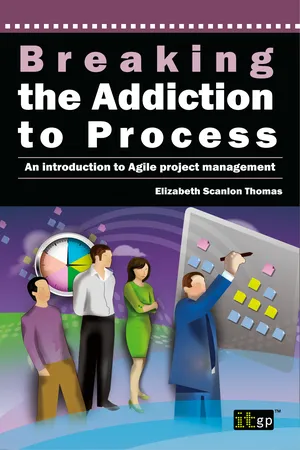
Breaking the Addiction to Process
An Introduction to Agile Project Management
- 129 pages
- English
- ePUB (mobile friendly)
- Available on iOS & Android
Breaking the Addiction to Process
An Introduction to Agile Project Management
About this book
Not sure if you want to become Agile? This book will explain why you should.
We live and work in an age in which clients' needs are changing rapidly. Deadlines are shortening and existing development methodologies are relatively inflexible. Projects undertaken using these systems are coming up against increasing difficulties. Modern processes need to be fast-moving and adaptable to cope with the pace of business today.
Revolutionise your working practices with Agile
Agile development methods offer greater flexibility than traditional methods. Their emphasis on incremental testing allows maximum adaptability, giving you the tools you need to meet your customers' needs efficiently and cost-effectively.
Save time and money
This twelve-step guide will give you a clear understanding of the way Agile works. It can save you time and money by helping you to:
- improve your business practices
- develop your relationships with your customers
- work more efficiently with your colleagues
- create streamlined and successful working practices
Discover how Agile can help you deliver the results your clients want, and improve your own job.
Buy this book today and discover simple solutions to age-old problems.
Frequently asked questions
- Essential is ideal for learners and professionals who enjoy exploring a wide range of subjects. Access the Essential Library with 800,000+ trusted titles and best-sellers across business, personal growth, and the humanities. Includes unlimited reading time and Standard Read Aloud voice.
- Complete: Perfect for advanced learners and researchers needing full, unrestricted access. Unlock 1.4M+ books across hundreds of subjects, including academic and specialized titles. The Complete Plan also includes advanced features like Premium Read Aloud and Research Assistant.
Please note we cannot support devices running on iOS 13 and Android 7 or earlier. Learn more about using the app.
Information
CHAPTER 1: SATISFY THE CUSTOMER
THROUGH EARLY AND CONTINUOUS DELIVERY
The failure of traditional project management

Welcome to the flexible world of Agile
Epic | Highest-level requirement element. An epic is divided into lower-level requirements: Experiences and Enablers. It is planned to be released in a certain timebox, but development can take longer than that. |
Experiences | Experiences are easy to understand by the consumer (for example, ‘As a customer, I want a mobile phone that is easy to use.’) Experiences are similar to requirements in traditional project management. Completed experiences should be able to be demonstrated to customer or prototyped. |
Enablers | Enablers are technical features needed to implement Experiences. |
Product backlog | Prioritised list of user stories (requirements). |
Daily scrum | Short stand-up meeting. What did you do? What will do today? What is blocking you? |
Scrum master | Leads the daily scrum. Tracks work completed and remaining, and organises removal of things blocking the team. |
User stories | User stories are like traditional requirements, but expressed in sentences from the customer perspective (‘As a customer, I want a mobile phone that’s easy to use.’) |
Timebox | A year (approximately) of the project is called a timebox. This roughly equates to a traditional software product release. |
Train | A timebox is broken down into trains (sometimes referred to as an Experience Development Train (EDT)). A train lasts approximately 8 to 10 weeks. |
Sprint | A train contains s... |
Table of contents
- Cover
- Title Page
- Copyright
- Preface
- About the Author
- Acknowledgements
- Contents
- Introduction
- Chapter 1: Satisfy the Customer Through Early and Continuous Delivery
- Chapter 2: Welcome Changing Requirements
- Chapter 3: Deliver Working Software Frequently
- Chapter 4: Business People and Developers Work Together Daily
- Chapter 5: Build Projects Around Motivated Individuals
- Chapter 6: Convey Information via Face-to-Face Conversation
- Chapter 7: Working Software is the Primary Measure of Progress
- Chapter 8: Maintain a Constant Pace Indefinitely
- Chapter 9: Give Continuous Attention to Technical Excellence
- Chapter 10: Simplify – Maximise the Amount of Work Not Done
- Chapter 11: Teams Self-Organise
- Chapter 12: Teams Hold Retrospectives and Tune Their Behaviours
- ITG Resources